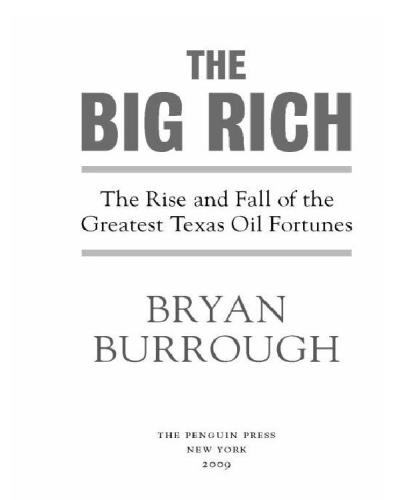
The Big Rich
The Rise and Fall of the Greatest Texas Oil Fortunes
- اطلاعات
- نقد و بررسی
- دیدگاه کاربران
نقد و بررسی

Starred review from November 3, 2008
Capitalism at its most colorful oozes across the pages of this engrossing study of independent oil men. Vanity Fair
special correspondent Burrough (coauthor, Barbarians at the Gate
) profiles the Big Four oil dynasties of H.L. Hunt, Roy Cullen, Clint Murchison and Sid Richardson, along with their cronies, rivals, families and, in Hunt's case, bigamous second and third families. The saga begins heroically in the early 20th-century oil boom, with wildcatters roaming the Texas countryside drilling one dry hole after another, scrounging money and fending off creditors until gushers of black gold redeem them. Their second acts as garish nouveaux riches with strident right-wing politics are entertaining, if less dramatic. Decline sets in as rising production costs and cheaper Middle Eastern oil erode profits, and a feckless, feuding second generation squanders family fortunes on debauchery and reckless investment—H.L.'s sons' efforts in 1970 to corner the silver market bankrupted them and almost took down Wall Street. This is a portrait of capitalism as white-knuckle risk taking, yielding fruitful discoveries for the fathers, but only sterile speculation for the sons—a story that resonates with today's economic upheaval.

December 15, 2008
Burrough (special correspondent, "Vanity Fair"; coauthor, with John Helyar, "Barbarians at the Gate") details the multigenerational saga of the "Big Four" Texas oil families of Roy Cullen, H.L. Hunt, Clint Murchison, and Sid Richardson, from the discovery of oil under Beaumont, TX, in 1901 to the demolition of the infamous Shamrock Hotel, the last bastion of oil-fueled Texas excess, in 1987. Since Burrough favors the human-interest angle, the narrative really hits its stride when the focus moves to the Hunt family in the 1960s. The real-life inspiration for the television show "Dallas", the Hunts prove the adage that truth is stranger than fiction. In addition to splurging and feuding as only billionaires can, they (allegedly) masterminded the JFK assassination and later threw Wall Street into chaos with their fixation on converting their family fortune into silver ingots, precipitating what at the time was the largest bailout in U.S. history. This book is an entertaining look at the larger-than-life histories of the incomprehensibly rich and powerful. While it's an extensively researched synthesis of a time and a place, it avoids a dry, academic tone through the natural drama of these miniature empires and the truly bizarre characters that inhabited them. Recommended for all libraries.Robert Perret, Univ. of Idaho, Moscow
Copyright 2008 Library Journal, LLC Used with permission.

Starred review from December 1, 2008
The Texas oil fortunes forged by independent oilmen, known as wildcatters, had its roots in the first oil strikes during the 1890s, but it was during the Great Depression that Roy Cullen, Clint Murchison, Sid Richardson, and H. L. Hunt, known as the Big Four, rose to affluence in Texas society to become the Big Rich. By the 1950s, these families emerged as some of the richest in America, yet almost no one outside the insular world of Texas oileven knew they existed. The most colorful of them, H. L. Hunt, was a bigamist with three separate families that he managed to keep secret from each other for years. His sons, Bunker and Herbert, are famous for their botched attempt to corner the silver market that nearly brought down the entire financial system in 1981. Burrough chronicles three generations of these oilmen, whose legacy includes the birth of the ultraconservative political movement and the archetype of the flamboyant Texas oilman with scores of ranches and airplanes, wielding the power of a J. R. Ewing. Burrough, a special correspondent at Vanity Fair and author of numerous best-selling books, invokes a tale of bitter competition, family feuds, booms, and bankruptcies that more than lives up to the legends.(Reprinted with permission of Booklist, copyright 2008, American Library Association.)




دیدگاه کاربران